
HOME
INTRO
SYMBOLS
ALMANAC
ECONOMY
GEOGRAPHY
STATE MAPS
PEOPLE
FORUM
NEWS
COOL SCHOOLS
STATE QUIZ
STATE LINKS
BOOK STORE
MARKETPLACE
NETSTATE.STORE
NETSTATE.MALL
GUESTBOOK
CONTACT US


Dbl click any word in
document for definition.
Texas State Gemstone Cut
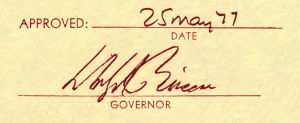
Governor Dolph Brisicoe's Signature
House Concurrent Resolution No. 97
The Lone Star Cut, designed by brothers Dr. Paul W. Worden, Jr. and Gary B. Worden, became the official state gemstone cut of the State of Texas when Governor Dolph Briscoe signed House Concurrent Resolution No. 97 on May 25, 1977.
If you guessed that Texas is the only state with an official gemstone cut, you would be right!
The Lone Star Cut is often applied to Texas' official state gem.
H.C.R. No. 97
HOUSE CONCURRENT RESOLUTION
WHEREAS, The flag of Texas, the public symbol for all to see, has a lone star as its prominent feature; and
WHEREAS, This is reflected in the State slogan "Texas--The Lone Star State"; and
WHEREAS, A special gemstone cut known as the Lone Star Cut has been designed by two native Texans; and
WHEREAS, Any gemstone may be cut in this manner, including the State Gem, the Blue Topaz; and
WHEREAS, The special characteristic of the Lone Star Cut is the appearance to the viewer when looking directly into the stone, in that it reflects the five-pointed star; now, therefore, be it
RESOLVED, by the House of Representatives of the State of Texas, the Senate concurring, That the Lone Star Cut be and is hereby designated as the official State Gemstone Cut of Texas; and, now, be it
RESOLVED, That the specifications for faceting the Lone Star Cut are for an 80 index gear and shall be as follows:
PAVILION
1. Cut 10 facets at 45°. Index 4-12-20-28-36-44-52-60-68-76.
2. Cut 5 facets at 54°, until the star is a measured 65 percent of the diameter of the stone. Index 80-16-32-48-64.
3. Cut 10 facets at 60.7°. Index 2-14-18-30-34-46-50-62-66-78. These are to meet the points of the star exactly.
4. Cut 5 facets at 65°. Index 8-24-40-56-72. These should also meet the points of the star exactly.
5. Prepolish in the same order, then polish from the culet to the girdle.
CROWN
1. Cut 10 facets at 41.5° Index 2-14-18-30-34-46-50-62-66-78. These should be cut until the girdle is of the proper thickness.
2. Cut 5 facets at 52.1°. Index 8-24-40-56-72. Cut these until they match the corresponding facets of the pavilion in width at the girdle. This will insure the proper size for the table.
3. Cut 5 facets at 30°. Index 80-16-32-48-64.
4. Cut the table at 0° until the 30° facets meet at a point.
5. Prepolish in the same order, then polish in reverse order. If desired, the table may be cut and polished last; it depends on your machine. The girdle may be polished or not, as you wish.
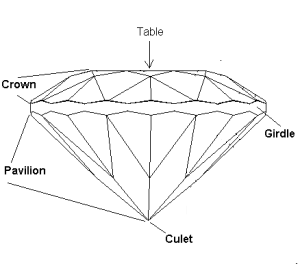
Diagramed definitions used in
House Concurrent Resolution No. 97.
Diamond and triangular shapes represent "facets."
Some definitions...
pavilion - the bottom part of a cut gemstone.
crown - the top part of a cut gemstone.
facet(s) - flat surface(s) of a gemstone, geometrically arranged to bring out the brilliance of a gem. There are different facet styles.
culet - flat surface on the bottom of a cut gemstone.
girdle - the widest part of a cut gemstone.
table - the top surface of a cut gemstone.
Texas Law
The lone star cut was named the official State gemstone cut of Texas by House Concurrent Resolution and is not, therefore, listed in the Texas Statutes.
Only a few of Texas' myriad symbols were actually adopted by an act of the legislature and written into the Texas Statutes.
Sources...
"House Concurrent Resolution No. 97." Legislative Reference Library of Texas. Legislative Reference Library of Texas, n.d. Web. 10 Dec 2011. .
"Gem, mineral show to have rare pieces." Midland Reporter-Telegram 06 Nov 1977, 7. Print.
Worden, Gary B.. "History of the Lone Star Cut." Gary's Gems. Gary's Gems, n.d. Web. 10 Dec 2011. .
Shearer, Benjamin F. and Barbara S. State Names, Seals, Flags and Symbols: A Historical Guide Third Edition, Revised and Expanded. Westport, Conn: Greenwood Press, 3 Sub edition, 2001.
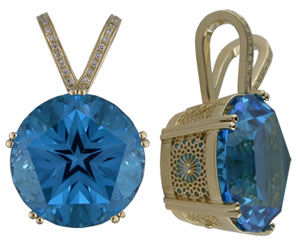
Texas State Gemstone Cut: Lone Star Cut
Photograph: C. Kirk Root Designs. Used with permission.
Additional Information
HISTORY of the LONE STAR CUT: Gary B. Worden's website, Gary's Gems.
Faceting Instructions - Rectangle Cut: Step by step guide from PrettyRock.com
Faceting Process: Step by step, in pictures, describing how a rough stone becomes a faceted sphalerite gem using a faceting machine.
Introduction to Faceting: Over twenty web pages from Ron Gibbs.
Online education for gem enthusiasts: GemSociety.Org.
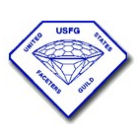
United States Faceters Guild
United States Faceters Guild: Official website of the United States Faceters Guild.
More symbols & emblems: Complete list of official Texas state symbols from NETSTATE.COM.

Faceting History
Glenn Klein
Faceting History: Cutting Diamonds and Colored Stones, by Glenn Klein. 242 pages. Publisher: Xlibris (October 13, 2005) A thorough and interesting study of the faceting (cutting and polishing) of gemstones. Tools and technique used with diamonds vary greatly from all of the other gemstones like Emerald, Ruby, Sapphire, and Aquamarine, etc. The required processes are well described in the Faceting History and numerous old pictures are included. The book is a welcome sharing of faceting knowledge. This is a dramatic change from the centuries old way of withholding information and keeping secret the ways to improve the appearance of diamonds and colored gemstones. Glenn Klein has been faceting colored gemstones for nearly fifty years.
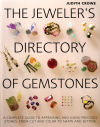
The Jeweler's Directory
of Gemstones
Judith Crowe
The Jeweler's Directory of Gemstones: A Complete Guide to Appraising and Using Precious Stones From Cut and Color to Shape and Settings, by Judith Crowe. 176 pages. Publisher: Firefly Books (October 9, 2006) The trade of gemstones is a highly specialized and often secretive business. Using The Jeweler's Directory of Gemstones, written by an expert gemstone dealer and designer, will provide any consumer with the insider knowledge needed to make accurate judgments of gemstones, to recognize low- and high-quality stones, and to make a good buy rather than a bad one. No other book has this kind expert advice -- up-to-date, clearly presented and fully illustrated -- on evaluating and using gemstones.
Crystal & Gem (Eyewitness Books), by R.F. Symes and R.R. Harding. 72 pages. Publisher: DK Dorling Kindersley (June 25, 2007) Reading level: Ages 9-12. Be an eyewitness to the stunning natural beauty of crystals of every size, shape, and color -- and their remarkable uses for everything from surgeons' scalpels to silicon chips. Full-color photos. Learn about the formation and practical uses of crystals, semiprecious stones, and precious metals. "The dazzling full-color photographs on uncluttered pages make this a visual treat."--School Library Journal. Clip-art CD included.
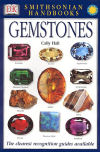
Gemstones
Cally Hall
Gemstones (Smithsonian Handbooks), by Cally Hall. 160 pages. Publisher: DK Dorling Kindersley 2 edition (May 15, 2002) The Smithsonian Handbook of Gemstones is packed with more than 800 vivid full-colour photographs of more than 130 varieties of cut and uncut stones, organic gemstones and precious metals. With authoritative text, clear photography and a systematic approach, this concise guide to identification enables you to recognize each gemstone instantly.
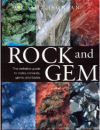
Rock and Gem
Ronald L. Bonewit
Rock and Gem, by Ronald Louis Bonewit. 360 pages. Publisher: Covent Garden Books; 1st edition (2008) From glittering gemstones to fascinating minerals and fossils, Rock and Gem is an incredible celebration of the Earth's buried treasures. Including specially commissioned photographs of more than 450 illustrious specimens and information-rich text, this book illustrates each stone¹s unique characteristics and its relationship to humankind through the ages. About the Author With more than 40 years experience as a geologist, prospector, and gem cutter, Dr. Ronald L. Bonewitz provides a unique perspective on the subject.

